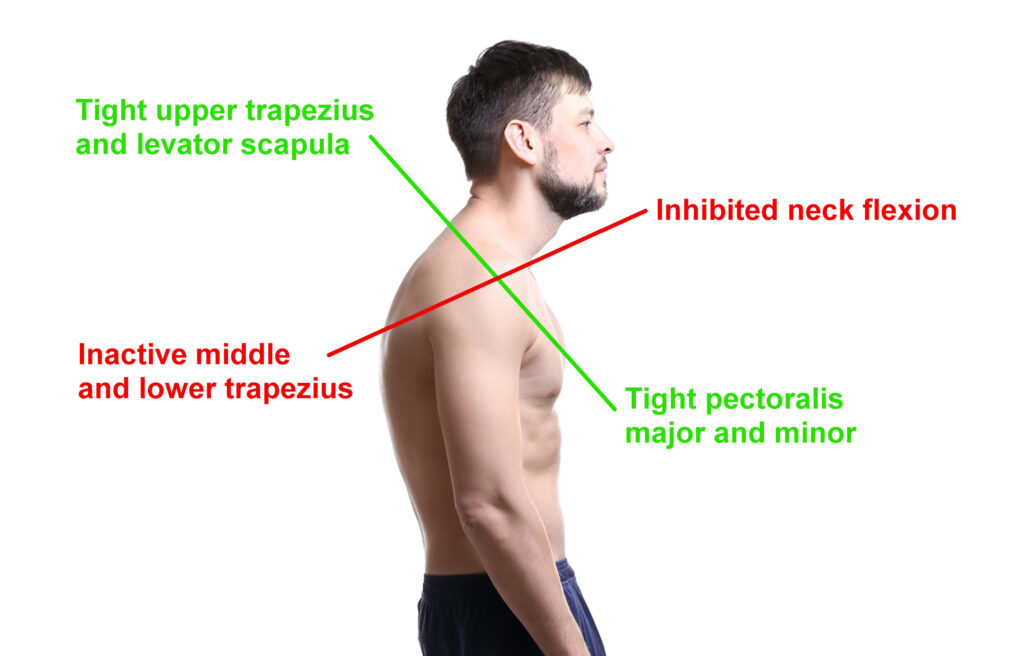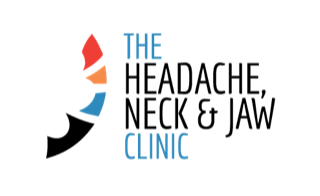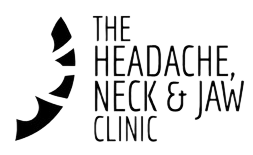What is Upper Crossed Syndrome
Upper Crossed Syndrome (UCS) is a musculoskeletal condition characterised by muscle imbalances and poor posture, leading to a forward head posture and rounded shoulders, which can lead to symptoms like tension headaches, migraines, jaw grinding or clenching, or Temporomandibular Disorder (TMD).
UCS and Muscular Imbalance
Upper Crossed Syndrome (UCS) involves a characteristic “X” pattern of muscular imbalance. Certain muscles, like the upper trapezius, levator scapulae, and pectorals, become tight, while others, such as the deep neck flexors, lower trapezius, and rhomboids, are weakened.

Causes of UCS
- Sedentary Lifestyle: Sitting for long periods, especially in office settings, is a major contributing factor.
- Repetitive Movements: Performing the same motions repeatedly can also worsen the imbalance, for example, using the computer mouse while working at the desk.
- Poor Posture Habits: Consistently slouching, spending a long time on your phone or electronic device, or holding your head in a head-forward posture over time can lead to UCS.
Symptoms of UCS
- Pain: Often felt in the neck, upper back, and shoulders.
- Headaches: Frequently described as tension-type or even migraine-like headaches.
- Limited Mobility: Stiffness and reduced range of motion in the neck and shoulder areas.
- Jaw Discomfort: Pain or tension in the TMJ (jaw joint) can also occur.
- Numbness or Tingling: These sensations may be felt in the arms or hands.
- Daily Activity Challenges: Tasks like reading, driving, or sitting for extended periods may become uncomfortable or painful.

Treatment of UCS
- Physiotherapy targeted Exercises: Focus on stretching tight areas (like the chest) and strengthening weak muscles (like the neck flexors and lower traps).
- Manual Therapy: Gentle joint mobilisation techniques can ease pain and improve the function as well as range of motion of the neck and upper back.
- Postural Awareness: Learning and maintaining appropriate posture while sitting, standing, or using devices is essential for managing UCS long-term.
Gaming, Teenagers & UCS
Teenagers are increasingly affected by Upper Crossed Syndrome due to long hours of gaming and high screen time. Extended periods of sitting, poor ergonomics, and slouched posture during gaming or device use can lead to the same muscular imbalances seen in UCS.
Teen gamers often maintain a forward head posture, rounded shoulders, and a hunched spine especially when using handheld devices or sitting too close to screens.
The lack of movement during long gaming sessions further contributes to muscle weakening and tightness, increasing the risk of UCS.
How to help teenagers suffering from UCS
- Educating teenagers on proper posture and the importance of breaks during screen time.
- Setting up gaming stations ergonomically, with monitors at eye level and supportive chairs.
- Encouraging regular physical activity and posture-corrective exercises to balance screen time.
- Including stretching and strengthening routines in daily habits to prevent long-term postural issues.
Book an initial UCS treatment appointment
The Headache Neck and Jaw Clinic are experts in the diagnoses and treatment of complex headache, neck and jaw issues. If you are suffering from Upper Crossed Syndrome, book an appointment today.

Lisa Eisfeld is a trained physiotherapist from Germany. She has also studied advanced Manual therapy and finished her Osteopathy Diploma in 2018 at the School for Manual Medicine Berlin. Lisa has also attained her Watson Headache Institute Level 1 Foundation and Level 2 Consolidation courses. Read more about Lisa.

